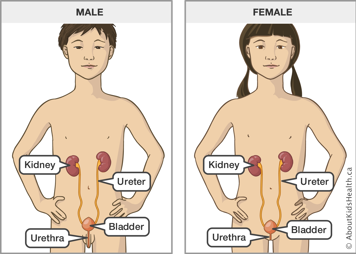What is a urinary tract infection?
A urinary tract infection (UTI) is an infection of the bladder or the kidneys.
Symptoms of a urinary tract infection
Symptoms of a urinary tract infection may include:
Causes of urinary tract infections
UTIs usually occur when bacteria from the skin enter the bladder through the urethra (the tube that allows urine to leave the body from the bladder). UTIs are more common in females, younger children and those with kidney or bladder abnormalities.

How urinary tract infections are diagnosed
Your child’s health-care provider will diagnose a UTI through testing a sample of your child’s urine. Diagnosis involves two steps:
- testing the sample of urine with a dipstick
- growing a culture (bacteria) of the sample in a laboratory
Urine sample
In toilet-trained children, the urine sample should be taken mid-stream. In children who are not toilet-trained, the urine sample can be collected by a “clean catch”, a catheter (tube) or, sometimes, a urine bag. A urine sample collected with a urine bag can be used to screen the urine for infection using a dipstick. If the dipstick result suggests there is an infection, a clean sample must be collected using another method to send to the lab to confirm a UTI.
Results of urine test
The health-care provider will consider the results of the dipstick test and the culture test. If the urine sample has been collected properly, a “positive” culture confirms a urinary tract infection. A “negative” culture confirms that there is no infection.
The final results of the urine culture test are usually ready in two or three days. The results will show which specific bacteria caused the infection and guide which antibiotics will treat them.
If a child’s urine has been collected in a urine bag and there is a positive result from a dipstick test, your child will need another urine sample collected by clean catch or a catheter and to be sent for further testing.
How to care for a child with a urinary tract infection
Antibiotics
Depending on your child’s age, symptoms and medical history, they may require either oral antibiotics (antibiotics by mouth) or admission to hospital for intravenous antibiotics (antibiotics given into the vein).
Your child’s health-care provider will first prescribe a broad-spectrum antibiotic (one that can treat most bacteria that cause UTIs). Once the final result of the urine culture is available, the antibiotic prescribed may need to be changed to treat the bacteria that is growing in the urine. Your child will only get better when they take the correct antibiotic for their infection.
Your child’s symptoms should improve within 48 hours of starting the correct antibiotic. Even so, continue to give the antibiotic to your child until it is finished. Finishing the antibiotic prevents the infection from returning and reduces the chance that your child will get an infection that is harder to treat with antibiotics in the future.
Pain and fever relief
Give your child acetaminophen or ibuprofen to help with any pain or fever. These medicines usually begin to work within an hour and do not interfere with antibiotics. You may need to give them during the first few days of treatment until the antibiotic starts to take effect.
Follow-up appointment
After your child starts antibiotics, make an appointment to see your child’s health-care provider. They can check how well the antibiotic is working and prescribe a different one if your child is still sick.
Other tests for children under two years
If your child has their first urinary tract infection with fever (known as a febrile UTI) before they turn two, they should have an ultrasound of their kidneys. Some children who have abnormalities on the ultrasound and those who have recurrent UTIs may benefit from other specialized tests. These tests look for kidney scars resulting from infection or for problems with the way urine drains the kidney or empties the bladder.
How to prevent a urinary tract infection
Most UTIs in young children are unavoidable. In an older child, you can help prevent a UTI by following the steps below.
- Teach your daughter to wipe from front to back after peeing. This is important after a bowel movement, as it helps to prevent bacteria in the stool from entering the urinary tract.
- Prevent your child from becoming constipated. Constipation means having bowel movements that are harder or less frequent than normal. It can sometimes prevent the bladder from emptying completely, leading to UTIs.
- Encourage your child to drink lots of fluid, to pee every two or three hours and to avoid holding in the pee for long periods.
- Some children with severe abnormalities of the urinary system and recurrent UTIs may need to take a low-dose antibiotic every day to prevent new infections.
When to see a health-care provider
Call your child’s health-care provider during office hours if your child’s symptoms last more than 48 hours after starting an antibiotic.
Take your child to the nearest emergency department if your child:
- is getting more sick or if you are concerned they are dehydrated
- complains of severe abdominal or back pain
- is vomiting (throwing up) repeatedly and cannot keep down any fluids or medicines
Your child may show physical changes when their condition is serious or when their condition gets worse. Parents and caregivers can learn how to
spot these signs in order to seek help from a health-care provider.
Matoo T.K., Shaikh N., and Nelson C. P. (2021, February 1). Contemporary Management of Urinary Tract Infection in Children. Pediatrics 147(2): e2020012138. https://doi.org/10.1542/peds.2020-012138
